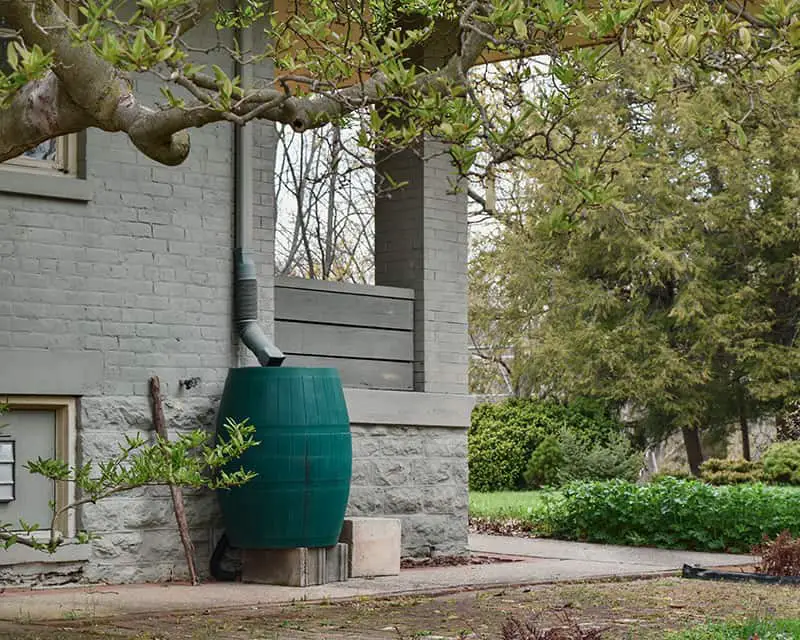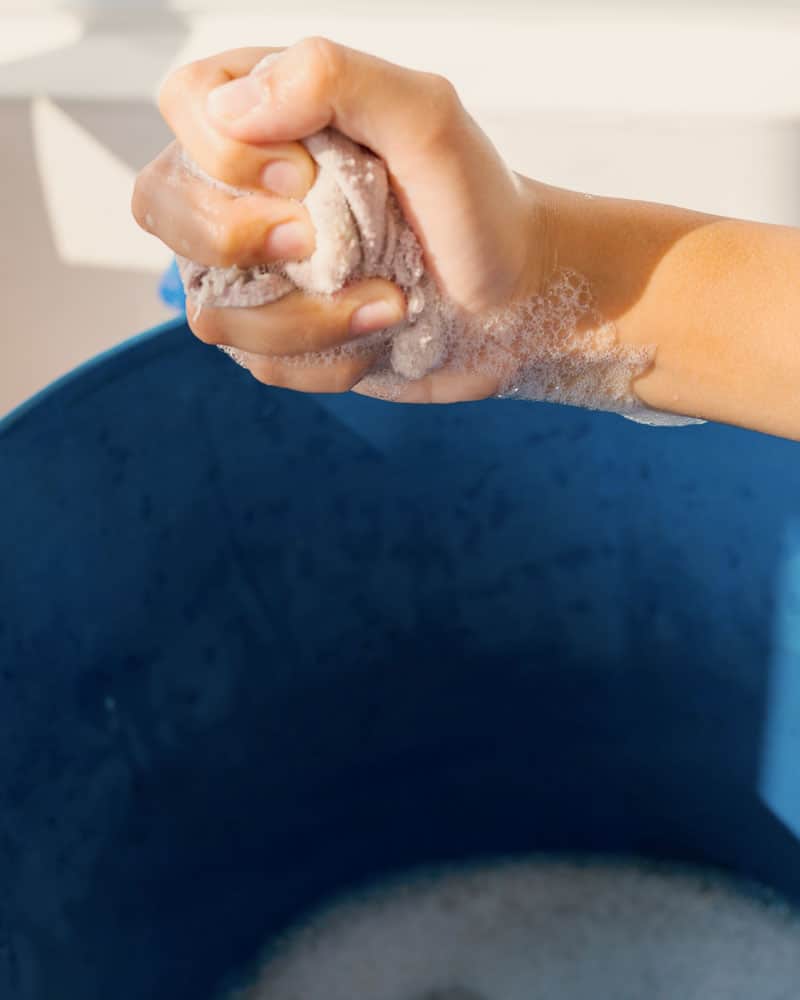You probably know the benefits of using rainwater for plants, but how long can you keep it and use it on your plants?
Generally, rainwater will become contaminated after about one week. You can prolong its lifetime indefinitely by keeping it out of the light and from animal and insect contact.
In this article, I explain what causes rainwater to go bad and how it can affect plants. I will also share a few tips to reduce the risk of contaminants in your rainwater.
Let’s get started!
Disclaimer: As an Amazon Associate I earn from qualifying purchases.
Does rainwater go bad for plants?
Several factors, such as direct sunlight exposure, air pollution, and contact with animals and insects, can cause stored rainwater to be unsafe for plants.
Let’s explore each of these causes:
Algae Growth
One of the most common problems with rainwater storage is the growth of algae in your tanks. The presence of algae will make harvested water unusable.

Algae require exposure to light and warm temperatures to thrive. This is why, if your rain barrel allows sunlight to get through or it is placed outside where the sun shines down on it, algae will grow.
Effect on plants:
If algae rainwater is used for watering, it can develop a layer of algae on the soil’s surface, preventing water from getting to the roots.
As the algae grow on the soil, it deprives the plant of its nutrients and decreases the oxygen levels in the soil.
Algae can also grow on leaves, blocking the light required for the plant to photosynthesize.
Altogether, algae-contaminated rainwater will stunt the growth of plants, and in some cases, even kill them.
Contamination from Air Pollution
When rain occurs in highly polluted cities with lots of power plants and automobiles, it can react with pollutants such as sulfur dioxide and nitrogen oxide to produce acid rain.
Effect on plants:
Plants thrive in slightly acidic conditions between 5.5 and 7.0 pH values.
However, acid rain has a pH level below 4.0, which causes the aluminum to be released in quantities that may stunt root growth and interfere with the plant’s uptake of nutrients.
Contamination from Dead Animals
When your barrel or water tank is not close properly, animals such as frogs, rodents, and birds can enter and drown.
Leaving a carcass in your rainwater tank for too long can attract flies, producing maggots and an awful odor.
Effect on plants:
I can’t imagine you will be using rainwater that is already contaminated with dead animals as it will make your garden and plants smell awful.
In addition, you are risking transferring any maggots present in the water to your soil which may damage your plants’ root system.
Mosquito Breeding
Rainwater tanks that have small openings will allow female mosquitos to enter and lay eggs.

Effect on plants:
Although they may not be harmful to plants, mosquitos carry the risk of bringing diseases like dengue fever, West Nile virus, and malaria.
Plants also serve as an ideal breeding place for mosquitos. As you continue to water your plants, slow-moving or standing water provides a warm environment for mosquito larvae to grow.
Should You Dispose of Contaminated Rainwater?
Using contaminated rainwater on edible plants and vegetables can cause them to be toxic and dangerous to consume.
You can water purely ornamental plants with rainwater that has been contaminated. However, this may result in discoloration, stunting, irregular growth, or death of the plant.
So, how do you check if it is still safe to use?
Check for an unpleasant smell.
Rotten egg or strong sulfur smell is a telltale sign of high bacteria levels in the rainwater.
Test the pH Level of your Harvested Rainwater
Acidic rainwater contaminated by impurities from pollution will have a pH level below 4.0, which is not suitable for plants growth.
Check if the harvested rainwater has a pH level between 4.5 to 5.5 with a pH meter.
Best Ways to Keep Rainwater Clean and Fresh for Plants
As I have mentioned, clean rainwater will last longer and provide many benefits for your plants.
Now I will share strategies that have worked well for me to keep my harvested rainwater clean from algae and contaminants.
Use Proper Collection Barrel or Tank
You could use either a barrel or a large water tank, depending on your watering needs. However, you should always make sure the harvesting container is cover properly and use good quality material.

Proper tight seal cover will prevent small animals, insects, and even twigs and dirt from getting inside the container.
Avoid metal or concrete water tanks because they can rust quickly. I currently use this 50-gallon plastic barrels. They block out light, which ensures no algae growth.
Install a Filter
Since most rainwater harvesting collects water from the roof, your rainwater might contain various contaminants, including dirt, leaves, bugs, and bird droppings.
You can install your rainwater filter on the gutter pipe or before the water enters the storage tank.
Either way, you must regularly clean the filters to prevent buildup and blockage.
Clean Containers Regularly
If you are using large buckets without proper lids, you should consider cleaning them every week.

Regular cleaning will prevent mosquitoes from breeding and algae from growing in your rainwater.
Empty and scrub the buckets with dish soap. Rinse repeatedly to remove any traces of soap residue.
Paint Barrel
Most plastic barrels are not entirely opaque, so they do not block all the light coming in. Which still allows for algae growth.
To keep light out, paint your barrel entirely black or brown.
Unfortunately, dark colors cause the barrels to absorb heat from sunlight more, making the rainwater temperature warm and act as a catalyst for mosquito breeding.
It’s best to store your barrels in a shady area and out of direct sunlight.
Use Oil to Prevent Mosquitos
As you know, oil floats on water. You can use a tablespoon of vegetable oil or fish oil to coat the surface of your rain harvesting container.
The oil will create a thin sheet of film that will prevent mosquito larvae from hatching and breeding in your harvested rainwater.
A small amount of oily residue might end up inside the water, but it would be harmless to plants.
When you have a rain barrel with an attached spigot, use the water below the oil layer and discard any remaining water as it reaches the tap.
Add Chlorine/Iodine Tablets
You can use an appropriate amount of bleach or chlorine to fight against algae growth on your harvested rainwater.
I’ve experimented with using a ¼ teaspoon of chlorine per gallon of rainwater. The chlorine successfully eliminated algae growth, and the dosage is safe for my plants.
TIPS: Before use, you might want to test treated rainwater in a small part of your garden or potted plants. If signs of plant stress appear, then dispose of the rainwater and apply less chlorine next time.
Related Questions:
Do I Need to Boil rainwater to kill bacteria?
Boiling rainwater helps kill most contaminants, but it may cause your rainwater to be less acidic and less beneficial to your plants. Also, it would be best if you allowed boiled water to reach room temperature before using it for watering.

